#Porphyry stone
Photo

“Seated Apollo” with a lyre, red porphyry and white marble, 2nd century CE
A few sources identify this as a statue of the goddess Rome that was renamed “Seated Apollo” after a 19th century restoration.
Photo by Charles Reeza at the National Archaeological Museum, Naples
#red porphyry#ancient art#stone carving#Greek and Roman mythology#deities#Farnese collection#Napoli#Italy
191 notes
·
View notes
Text
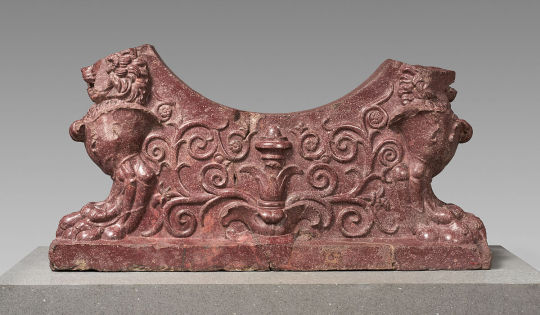
Porphyry support for a water basin. Roman 2nd century CE. x
In antiquity, porphyry was highly regarded as a royal stone, because its color was associated with the regal and, in Roman times, imperial use of purple to symbolize rank and authority. In addition, this very hard stone is found only in the eastern deserts of Egypt, making its extraction and transport extremely difficult and costly. Its use in Roman sculpture and architecture was therefore limited. This massive piece is one of a pair of supports that originally carried a deep oblong water basin, probably located in a major imperial bath complex. It exemplifies the opulence of Roman imperial sculpture at its height and is the most sumptuous ancient porphyry carving in an American collection.
51 notes
·
View notes
Photo
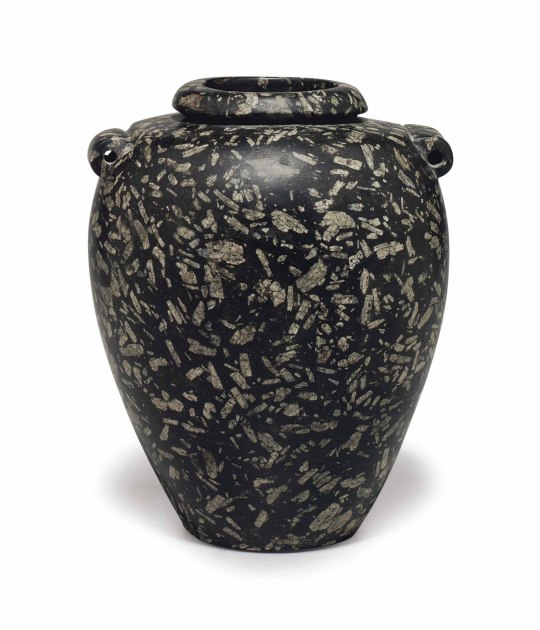
Jar - andesite porphyry - Early Dynastic Period, Egypt - 3100-2686 BCE
34 notes
·
View notes
Text
i love to go to the museum and immediately gravitate towards the most fucked up rock possible
#dare i say it is a hobby. anyway when i have access to my laptop again. deep dive into ‘fetid stone’#etruscans apparently found a type of rock that Smells Awful when you cut it and were like perfect. we will use it to make FUNERARY URNS#smells of sulphur and acc. to things i skim read on google scholar can sometimes burst into flames. can i speculate about the underworld.#too late i already am#also porphyry fuck you porphyry you sexy magnificent evil purple bastard#beeps
31 notes
·
View notes
Text
Rock Swag Tournament Round 1: Igneous Rocks Part 4
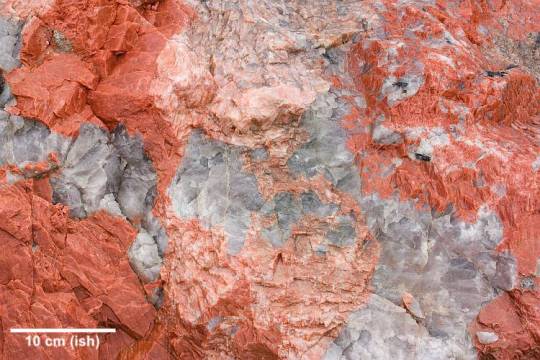

So these are two pretty fun igneous rocks, and the reason they're paired up is because neither of these two rocks has a defined composition. Granite is felsic, basalt is mafic, etc.
Now, many pegmatites are generally felsic, but it's not a requirement for pegmatites. Instead, what defines a pegmatite are the massive crystals it contains! I was taught, by a professor who does her research on pegmatites, that a good rule of thumb for when a rock is a pegmatite is when individual grains are bigger than a US quarter, but I've seen sources say grains have to be bigger than 1 cm. And, of course, in the sample shown above, those grains are more than 10 cm big.
All of that being said, one of the submitters to this competition ALSO has PhD research experience on pegmatites! I'll let them take it from here.
Pegmatites can have ENORMOUS crystals, rare minerals, and also gorgeous textures! Gemstone varieties of tourmaline, beryl, kunzite, etc. can come from pegmatites! My PhD research is on pegmatites XD
If this person would like to provide more information about pegmatites, I would be thrilled to hear it!
As for porphyry, while there is no compositional requirement, certain rocks like andesite and dacite are commonly porphyritic. One submitter actually sent in a specific type of porphyry called a rhomb porphyric (in English), named for its rhombic phenocrysts (the chocolate chips in the rock-cookie).

Here is what they have to say:
Found in Norway, east-Africa and Antartica. They look amazing! and can be found here in Denmark as a result of ancient glacier-movements - I am always super hyped to find one of these beauties. Plus the Danish name (rompeporfyr) sounds alot like rumpe-på-fyr meaning ass-on-guy (a more moderne translation might be Caked Up Dude) and I have been in love with that fact, and that stone, since I found out in grade 3.
Happy voting!
123 notes
·
View notes
Text
Thanatos Deity Guide
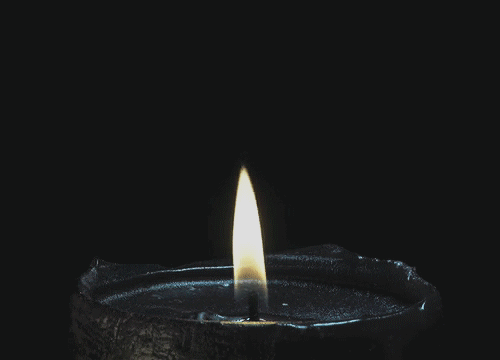
Who is Thanatos?
Thanatos is the personification or the spirit of death. In this way, Thanatos is considered a daimon in the original meaning, a spirit.
Thanatos was often depicted as a young male with wings, but occasionally he was depicted as an older man with a beard. He as well as his twin brother, Hypnos, are seen in ancient art holding torches turned upside down.
His role in mythology is a psychopomp—a being who carries the souls of the dead to the underworld. Though he was often referred to in myths, he rarely appeared physically.
Parents and Siblings
Nyx (mother)
Erebos (father in some myths)
with his being mother, Nyx, has many siblings. Most notibly:
Hypnos (twin brother)
The Keres (sisters)
Geras (brother)
Eris (sister)
Nemesis (sister)
The Moirai (sisters)
Apate (sister)
Charon (brother)
Lovers or Partners
Makaria according to some
Children
None
Epithets
Mors (Roman)
Letum (Roman)
Paian (Healer or Striker)
Acherontis (Woeful)
Leukokhrotos (White-Skin)
Notes
Though there are no ancient cults known to be dedicated to Thanatos, there have been traces of sacrifices left to him as well as a temple in Sparta.
In one myth, Zeus commands Hypnos and Thanatos to carry the dead body of the warrior Sarpedon off of the battlefield and to the country of Lykia so that he could be given a proper burial.
Other popular stories involving Thanatos are the story of Sisyphus and the story of Hercules wrestling Thanatos.
Thanatos has been depicted in art as a youth holding a butterfly or an inverted torch. The former represents a soul (the greek word for butterfly can also mean life or soul), and the ladder represents a life having been extinguished. He is also seen with a wreath of poppies or a sword.
In art and literature, Thanatos is also depicted as a cloud or mist that hangs above a person’s head who is soon to die.
He lives in the Underworld with his twin brother.
In some myths he is considered cruel, in others, he is considered sweet, as he is peaceful death. The descriptors chosen would likely depend on the writer’s outlook on death.
Modern Deity Work
Since there is very little record of historical record, this list has been compiled based on Thanatos' myths as well as what is known about him historically. In this list I have also compiled items from modern witches' posts about Thanatos, these posts will be in the References and Further Reading section.
Rocks/Stone/Crystals
Porphyry
Onyx
Obsidian
Iron
Bronze
Herbs/Plants
Poppy
Cypress
Animals
Butterfly
Snakes
Vultures
Crows
Symbols
Upside down torch
Sword
Butterfly
Wreath of poppies
Offerings
Any of the items or depictions of the items listed above.
Dead things that died naturally or peacefully. Or dead things that were ethically sourced.
It was common for Greeks to offer honey, olive oil, freshwater, and milk to their deities.
An altar or corner of your personal altar dedicated to him.
Jewelry dedicated to him.
Bones
Acts of Devotion
Learn about him, his brother, and his mother.
Learn about thanatology (study of death and dying)
Take care of those in hospice.
Show respect and appreciation for hospice workers.
References and Further Reading
Britannica
Theoi Project
Greek Mythology
World History
Mythus
The Underworld Oracle
Amino - Thana
Devotee of Thanatos - Tumblr
If you or anyone you know works with Thanatos and you welcome questions about him please feel free to reach out to me so that I can add you to this post!
337 notes
·
View notes
Text
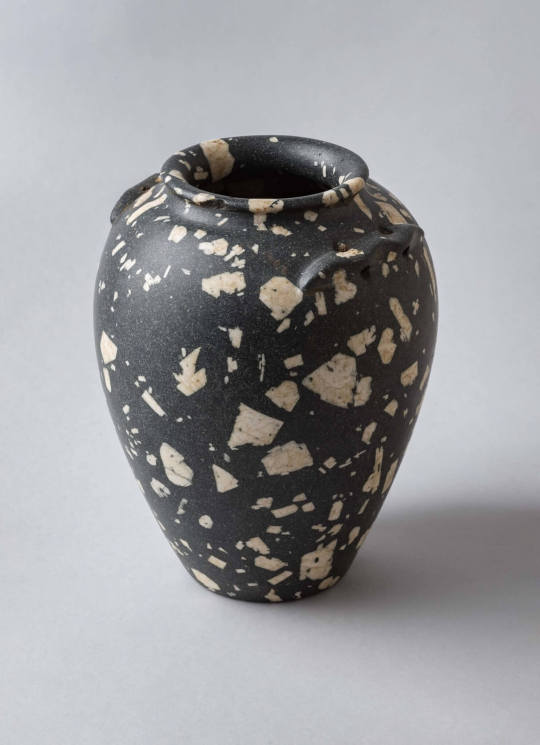
Andesite porphyry jar with wavy handles
This jar was found in a tomb dated to the Old Kingdom. An object handed down from generation to generation: the wavy handle is in fact a decorative motif typical of the Predynastic Period.
The working of stone vessels was perfected over the fourth millennium, and large numbers were produced in the Early Dynastic Period, following the unification of Egypt.
To make this vase was used a rock, called black porphyry, composed of minerals of different sizes. This choice has made the process far from easy because these minerals respond differently to mechanical stresses, increasing the risk of breakage.
Old Kingdom, 3rd Dynasty, ca. 2592-2544 BC. Dimension: 23 x 18.3 x 20.7 cm. From Gebelein. Now in the Egyptian Museum of Turin. S. 14089
Read more
34 notes
·
View notes
Text

East Aquhorthies Stone Circle Sunset, Aberdeenshire
Erected about 4,000 years ago, East Aquhorthies Stone Circle is a recumbent stone circle – a monument type only found in north-east Scotland. It has a large stone set on its side and flanked by two upright stones, usually on the south or south-west part of the circle.
The stones here appear to have been chosen for their colour. They’re all rough, pinkish porphyry, except for:
the stone next to the east flanker, which is red jasper
the two flanking stones, either side the recumbent stone, which are grey granite
the recumbent stone, which is made of red granite quarried from near Bennachie which you can see in the background.
Located near Inverurie in north-east Scotland, it is one of the best-preserved examples of a recumbent stone circle and one of the few that still have their full complement of stones and the only one that has all its stones still standing without having been re-erected.
The placename Aquhorthies derives from a Scottish Gaelic word meaning "field of prayer", and may indicate a "long continuity of sanctity" between the Stone or Bronze Age circle builders and their much later Gaelic successors millennia later.
5 notes
·
View notes
Note
My gf is doing a research project on sixteenth century recipe books (building a tool to help people read/understand them) and this weekend she was telling me about an ingredient that showed up in one of them that she could not figure out what it was. I have read the soap post (which is SO COOL, btw, I am so excited to see how the wash balls turn out) and I’m wondering if you might know what it actually is.
She first saw it written as venus bolearmonack, but we found several different spellings for it when we both went down internet rabbit holes: bolearmonack, bolarmonack, bolarmonicke. We think it’s maybe some sort of dirt or clay? But it keeps bothering me that we couldn’t figure it out, and reading your post made me wonder if you would know.
OKAY SO:
From Charas's The Royal Pharmacopœea, we know that:
By Minerals I understand all Metals, Half-metals, and what belongs to Metals. All sorts of Earths, and Bole-Armoniack; all Stones, Marbles, Flints, Porphyries, Jaspers, Chrystals, Jacinths, Emraulds, Saphirs, Granats, Blood-stones, Diamonds, and all sorts of Jewels: Sulphurs, Vitriols, Allums, Sal Gem, Bay-salt, Water, Rain, Snow, Ice, Hail, Thunder-bolts, Dew, Manna of several sorts, Morter, Lime, Brick, Oyl of Naphta Amber-griece white and yellow; Jet, Sea-coal and all Bitumens. Talk, Chalk, Bismuth, Zink, and all Marcasites, the ordinary Earth, Sand, Clay; and in general whatever is drawn out of the Bowels of the Earth, or Sea; or descends from the Air, being without Life.
This is Moyse Charas telling us what a shorthand (Minerals) means -- so apparently, Bole-Armoniack (another spelling!) wasn't a shorthand for something else the way, say, "the four greater Cold seeds" are. I also included the full paragraph because that also gives a hint as to what Bole-Armoniack isn't -- or at least, they didn't think it was... which means nope, not clay or dirt.
Later we find out in the same book that it's something you gotta crush the shit outta in a mortar before you can use it, but when you do it'll reduce to an extremely fine powder the way precious stones and amber will.
Lémery's A Course of Chemistry clarifies for a recipe for, ta da, gonorrhea, that:
Litharge, which is a Lead Calcined [a heated lead], Alom, and Bole-Armenick, are so many considerable Astringents, that do no hurt in this composition.
Which is to say, bole-armenick (ANOTHER SPELLING), when powdered, can be heated up to be used in this mix and was added because it was thought to draw together or contract skin tissue. It's also interesting that Lémery bothered to define litharge (which is fairly common in recipes I've seen), but, again, not the bole-armenick.
Finally, on a hunch, I did a search for just "armenick", and hit enough paydirt that I suspect y'all can dig further using it to confirm the results-- Pettus's 1683 glossary supplement to Ercker's Fleta Minor lists the following:
ARMENICK▪ See Armoniack.
ARMONIACK, T. gives it the Latine Name, Bolus Armeni, and we Bole Armoniack, and I find these words of kin, both in their Orthography and Pronuntiation, viz. Amoniack Armenick and Armoniack. The first Pliny tell us, is a Gum which he calls Gumma Amoniaci, of a glutinous nature (like other Gums) and so may be used for Metallick Vessels. The second viz. Armenick; I find the word Sal always joyned with it, and so called Sal Armenicus, and this Salt was antiently accounted a natural Salt, but that being now unknown to us, we use the Armenicus, which is made of the Urine of Elephants or Camels (as 'tis said) boyled to a Lixivium or Salt, and called Sal Armenius or Armeniacus, and this is of great use for purifying and refining of Metals. To the third Armoniacus the word Bole is added, I suppose for distinction sake: Pliny, c. 35. mentions a Stone, which he calls Lapis Armeni, of which he counts several sorts, but the best of those he saith, are of a blew colour, and calls it verd de Azure (being of great price and esteem with Painters, but the common Armoniack he calls Synoper (and we Synople) from a City of that name, where it was plentiful, and 'tis probable this is the same which we call Bole Armoniack, being of a reddish colour, and this is oft used by our Author, and for distinction the word Gum is put to the first, Salt to the other, and Bolus to this: which I write to prevent Errors in Medicines or Metallick Experiments.
So with Pettus's definitions, triangulated with Charas's shorthand notes and Lémery's preparation instructions, we arrive at your "venus bolearmonack" probably being sinople, a "ferruginous quartz that is blood-red or brownish red sometimes with a tinge of yellow" which "occurs in small but very perfect crystals, and in masses that resemble some varieties of jasper."
All that being said, though: always try and get at least one other source to confirm a definition. My beloved Simon Barbe says that benzoin is also myrrh, and that's... that's not right, babe. So double-check, but-- here's a reasonable direction!
39 notes
·
View notes
Text
Plutarch is for us the chief mouthpiece of the theory that all religions are fundamentally one, under different names and with different practices. For him and Maximus of Tyre ‘the gods’ are symbolic representations of the attributes of a Deity who is in his inmost nature unknowable. Maximus and Dion Chrysostom are ‘modernist’ in their views about myth and ritual; Philostratus and Ælian are genuinely superstitious. The Hermetic writings are good examples of the Plutarchian theory. They show, however, that the combination of philosophic monotheism with popular polydaemonism was becoming difficult, though the writers are equally anxious to retain both, as indeed the Neoplatonists were. Syncretism was easier when the gods were regarded as cosmic energies, or when their cults were fused in the popular worship of the sun and stars.
Dionysus and Orpheus were two nearly connected forms of the Sun-god, and the worship of both was influenced by the rites of the Thracian Sabazius. The central act of both mysteries was the rending in pieces of the god or hero, the lament for him, his resurrection, and the communion of his flesh and blood as a ‘medicine of immortality.’ The Egyptian Osiris had also been torn in pieces by his enemies; his resemblance to Dionysus was close enough to tempt many to identify them. In the Egyptian worship the doctrine of human immortality had long been emphasised, and this was now the most welcome article of faith everywhere. It was easy to fuse these national mystery-cults with each other because at bottom they all symbolised the same thing—the hope of mystical death and renewal, the death unto sin and the new birth unto righteousness, based on the analogy of nature's processes of death and rebirth.
While Judaism was purging itself from its Hellenistic element and relapsing into an Oriental religion, the bond of union in a people who were determined to remain aliens in Europe, Christianity was developing rapidly into a syncretistic European religion, which deliberately challenged all the other religions of the empire on their own ground and drove them from the field by offering all the best that they offered, as well as much that they could not give. It was indeed more universal in its appeal than any of its rivals. For Neoplatonism, until it degenerated, was the true heir of the Hellenic tradition, and had no essential elements of Semitic origin. Christianity had its roots in Judaism; but its obligation to Greek thought began with St. Paul, and in the third century ‘philosophic’ Christianity and Platonism were not far apart.
The real quarrel between Neoplatonism and Christianity in the third century lay in their different attitudes towards the old culture. In spite of the Hellenising of Christianity which began with the first Christian missions to Europe, the roots of the religion were planted in Semitic soil, and the Church inherited the prejudices of the Jews against European methods of worship.
Hellenism was vitally connected with polytheism, and with the sacred art which image-worship fostered. These things were an abomination to the Jews, and therefore to the early Christians. We, however, when we remember later developments, must take our choice between condemning matured Catholicism root and branch, and admitting that the uncompromising attitude of the early Church towards Hellenic polydaemonism was narrow-minded.
Porphyry made a very dignified protest against the charge that the Pagans actually worship wood and stone. ‘Images and temples of the gods,’ he says, ‘have been made from all antiquity for the sake of forming reminders to men. Their object is to make those who draw near them think of God thereby, or to enable them, after ceasing from their work, to address their prayers and vows to him. When any person gets an image or picture of a friend, he certainly does not believe that the friend is to be found in the image, or that his members exist inside the different parts of the representation. His idea rather is that the honour which he pays to his friend finds expression in the image. And while the sacrifices offered to the gods do not bring them any honour, they are meant as a testimony to the good-will and gratitude of the worshippers.’ The early Christian horror of idolatry was a legacy from the Jews, who were, on the aesthetic side, too unimaginative to understand a mode of worship which for other nations is natural and innocent.
-- William Ralph Inge, The philosophy of Plotinus
13 notes
·
View notes
Photo
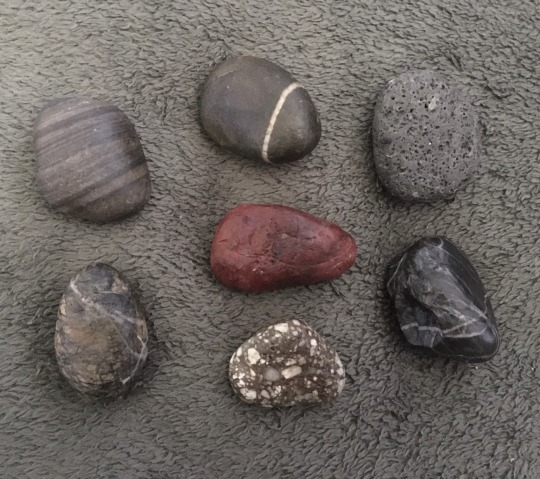
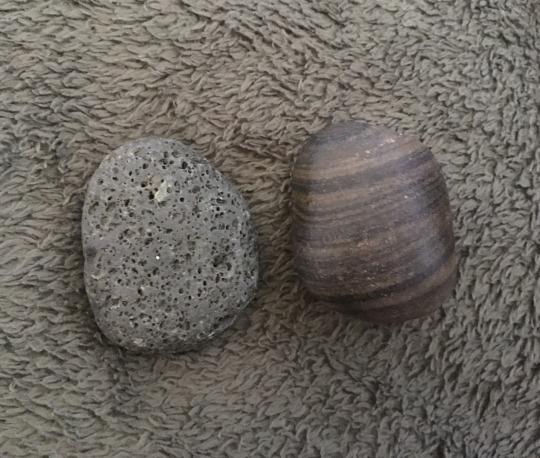

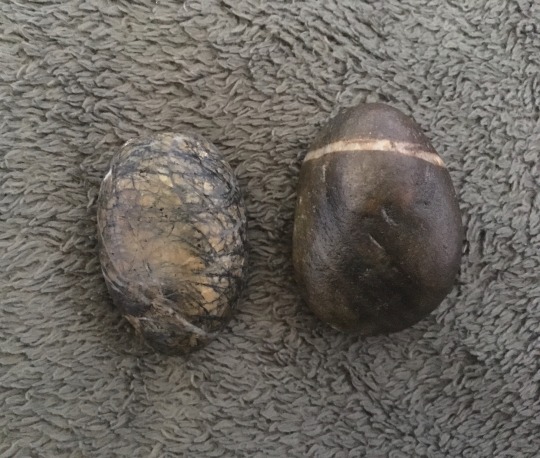
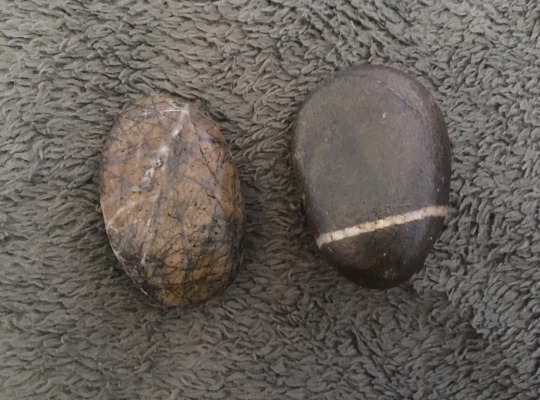
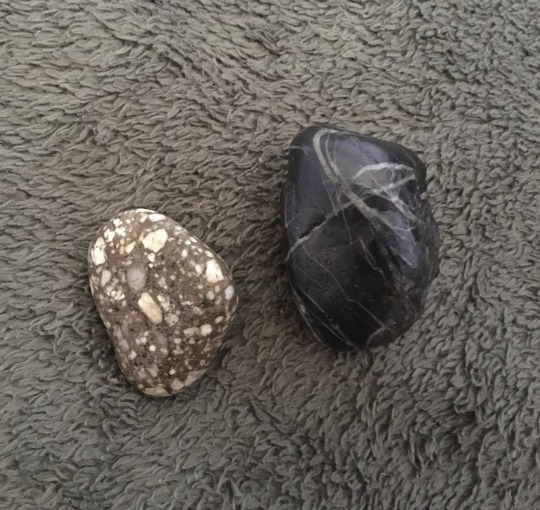


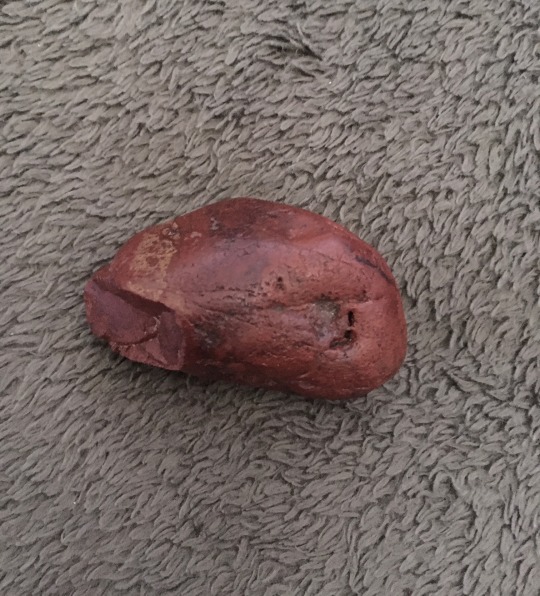
Some interesting rocks form the parking lot of a thrift store. There’s some striped ones, one that looks kinda like a lava rock, a porphyry stone, and a red one that looks like jasper.
#rocks#cool rocks#my post#my photos#my hoard#gremlincore#crowcore#corvidcore#forestcore#adventurecore#rock collection#rock hunting#rock collecting#dragon hoard#gremlin hoard#goblin hoard#dragoncore#rock collector#rangercore#mosscore#shinies#fairycore#rock hounding#cryptidcore#faecore#goblincore#stones#witchcore#mothcore#dirtcore
95 notes
·
View notes
Text
I’ve been down a rabbit hole wondering about medieval jewelry (and if I can reproduce it despite having no metalworking skills, to which the answer is mostly no) lately & I figured I would share the fruits of my museum collection searches for other medievalists/hobbyists/reenactors/nerds.
Jewelry of the 13th Century Anglo/Francosphere

TL;DR
Metals: 🟨 gold(tone)
Stones: mostly 🔵 cabochon, rarely 💠 simple cut, some carved 🗿 intaglio or cameo
Stone Colors: warm blues, emerald green, purples, burgundies, reds
Materials: enamel, 💎 gemstones (garnet, Ceylon sapphire, ruby/spinel, emerald) or glass paste imitations, ⚪ semi-precious stones (pearl, lapis, jasper, carnelian, coral, turquoise, porphyry)
Settings: bezel (oval and rectangular); ⚜️ intricate metalwork; more visible and textured metal than modern jewelry; more mixtures of stones and colors than modern tastes
Motifs: ◯ round, ✤ quatrefoil, ✙ cross, ✸ star (even numbers of points), ♣ trefoil, ❦ floral, 🐉 animals, 𝕬 inscription
Formats: brooches, ornamented clothing, rings, pendants, circlets, cuffs (rare)
A detailed look:
Some forms of jewelry that were very popular in the Roman Empire and are again today were just not the thing in the middle European Middle Ages. (Earrings, for example, seem to have barely existed. This is partially at least because ears were covered--by coifs and caps, hair, and (for women) braids or the chin strap and fillet/wimple/gorget.) In fact, a lot of the places we would put jewelry against our skin today were covered.
This left some other options:
Jewelry on Clothing
Medallions
Okay, these aren’t jewelry, strictly speaking, but they’re metalwork ornaments associated with a person.
Enamel Mitre Medallions


OA 3437 and OA 3438
Before 1291, Ile de France
Louvre, Paris
photos (c) Musée du Louvre / Stéphane Maréchalle 2015
Cloisonné and plique enamel over gold and copper, with decorative motifs of trefoils, quatrefoil, and stars in a palette of dark blue and green with accents that may once have been ruby red.
Appliqué Medallion
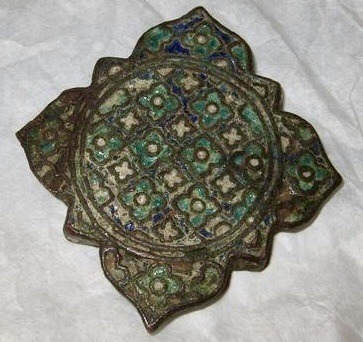
# MRR 256
13th c., Limoge
Louvre, Paris
photo (c) Musée du Louvre 2014
Gilded copper (though most gold is worn off) with quatrefoil champlevé enamel in emerald green, lapis blue, and white or off-white.
Brooches
Perhaps the most prevalent medieval jewelry item in the Anglo & French regions. These were worn at the shoulder for men and breast for women, often anchoring a cloak, or to close the collar. As the ornate fermail and double-ring brooch suggest, these ran the gamut from practical to incredibly decorative and ornate.
Garnet & Silver Gilt Animal Ring Brooch; Green and Blue Glass and Gilt Ring Brooch


Left, # 2003,0703.1
13th century; found in Suffolk, England
British Museum, London
photo (c) The Trustees of the British Museum
Right, # M.28-1929
13th c., England
V&A, London
photo © Victoria and Albert Museum, London
Cabochon garnets or carbuncles in the gilded silver brooch (L), perhaps once paired with smaller stones in the eyes of metalwork animals that bite the pin bracket. The right brooch, also silver gilt, sports two glass paste emerald and sapphire "gems" in cabochon. It was probably a lover's token; it reads (in Lombardic-lettered French) IOSV ICI ATI VCI or "jo su[i] ici a t[o]i v[o]ici" which I might translate as "I am here with/belonging to you, look!"
Ruby & Sapphire Ring Brooch; Sapphire, Garnet, and Pearl Fermail
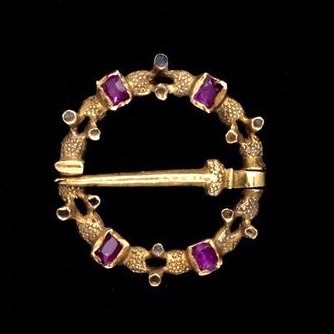
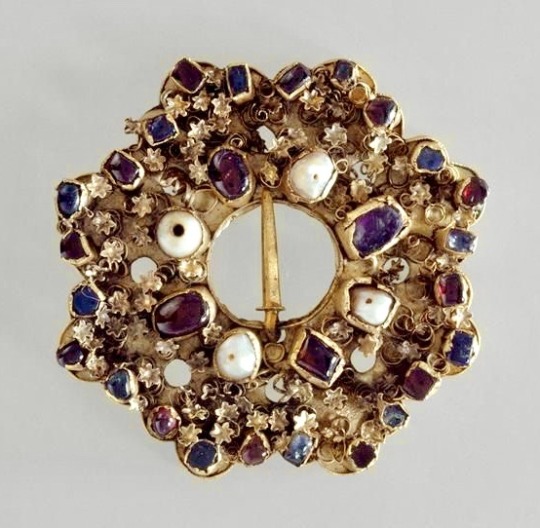
Left, # 6808-1860
1275-1300, England
V&A, London
photo © Victoria and Albert Museum, London
Right, # OA6287
1250-1300, France
Louvre, Paris
photo (c) Musée du Louvre
Blogs often claim that stones were only polished en cabochon until the 16th century, and that medieval jewelers couldn't cut gemstones. But this 13th-century gold ring brooch (left) pairs table-cut purple rubies with collet-set cabochon sapphires, and may evidence early medieval gem-cutting or reuse of Roman cut stones. The silver gilt fermail, right, includes pearl beads, garnets and sapphires both cut and cabbed, and one glass paste cabochon. Both are intricately textured, with punchwork (L) and floral metalwork, probably cast and then attached (R).
Double Ring Brooch with Sapphire and Glass "Emeralds"
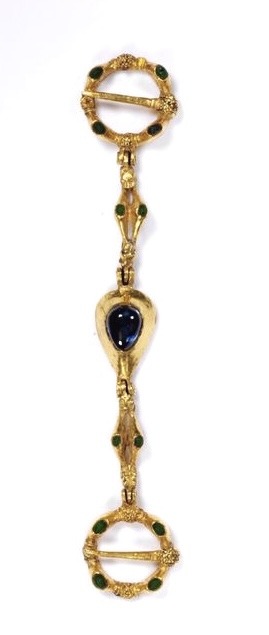
# M.26-1993
13th c., England
V&A, London
photo © Victoria and Albert Museum, London
This gold double brooch is so small they think it was for a woman or child. Central sapphire cab is flanked by glass paste "emeralds" in bezel settings and metalwork featuring two animal heads.
Jewelry on the Body
Rings
Many are probably familiar with the signet ring, used for pressing into sealing wax, which could be intaglio-carved gemstone or metals. There were also a number of decorative and/or talismanic gemstone rings.


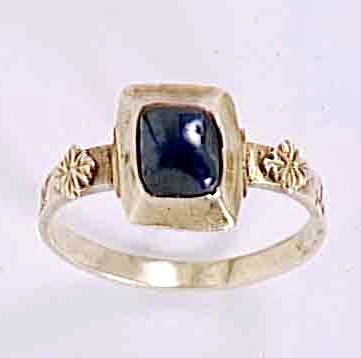
LtR:
#M.7-1929 | #M.180-1975 | #OA 11265
1250-1300, England | 1250-1300, Engl/France | 13th c., Engl/France
V&A, London | V&A, London | Louvre, France
photos L&C © Victoria and Albert Museum, London | R (c) Musée du Louvre
Sapphire in gold is the name of the game when it comes to rings in the thirteenth century; even the purple stones on the left are purple sapphires. (Sapphires were said to aid chastity, purity, and the effectiveness of prayer.) For larger stones, the bezel often has claws added (L); the central ring is an example of a full claw setting that modern viewers might find surprisingly tall. Naturalistic flourishes are added (C & R); these might be pre-cast then attached to the base (R).
Pendants
We equate pendants with necklaces, but their medieval applications also included wear as badges, from headpieces, and on horse decorations.


Left, bloodstone jasper cameo in silver setting
# MRR 218
1100-1300, France?
Louvre, Paris
photo (c) Musée du Louvre / Jean Blot 1984
Right, champlevé enamel, gilt copper, and paste "emerald" (harness) pendant
# 1976.169
13th c., France
Cleveland Museum of Art, Cleveland
photo CC0 Open Access
Statue Jewelry
From here, we get into the really ridiculous stuff; the previous categories could be relatively everyday (as much as ornamentation reserved exclusively for the wealthy can be an everyday thing) but the following examples are astonishing displays not necessarily for wear.
"La Couronne" de Vierge et l'Enfant d'ivoire de la Sainte-Chapelle

# OA 57 B
1250-1300, France
Louvre, Paris
photo (c) Musée de Louvre
This was not even a crown for a person, but rather for a painted ivory statue of the Virgin Mary, holding her infant son. (Though circlets, even set with stones, were sometimes worn as part of women's head dress.) It's incredibly ornate gold, set with pearls, garnets and rubies, sapphires, and turquoise (?) en cabochon.
Anneau de Saint-Denis




# MS 85 BIS
1200-1215, France
Louvre, Paris
photos (c) Musée du Louvre / Daniel Arnaudet 1990
This astonishing piece, which is ring-sized but now displayed as a cuff on an ivory hand, is made of gold and displays every possible gemstone appearance characteristic of the period. The front piece has a central sapphire and is surrounded by quartz with red backing (mimicking ruby/garnet), amethysts, pearls, and sapphires, some set on yellow backing (mimicking turquoise?). Most are en cabochon on this face, but two are faceted and two intaglio. Were this not enough, the three other 'faces' of the ring are set with gems as well, two cameos (probably sapphire and garnet?) and one amethyst intaglio set in ornate gold filigree.
#medieval#jewelry making#lapidary#history of fashion#historical jewelry#1200s#reenactment#England#France#enamel jewelry#ring brooch#fermail#intaglio#cameo#gemstones#infodumping#now time to go to the bead store#material history#you would think this is for my research or academically relevant but it's not I just couldn't stop looking at shiny things help#photos not mine#photos for educational purposes and not for commercial reproduction#louvre#v&a museum#british museum#cleveland museum of art
34 notes
·
View notes
Text
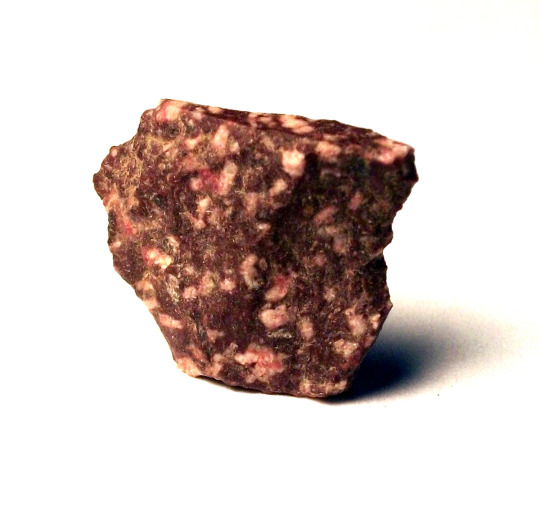
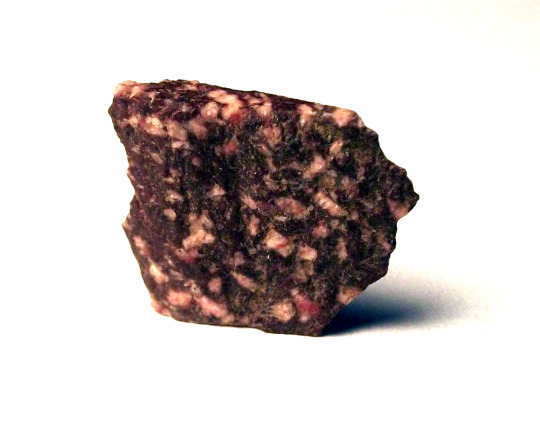
Egyptian Porphyry aka Imperial Porphyry (two views) - this 3/4" (2cm) chip was found on the walk from the parking lot up to the ruins of Hadrian's Villa in 1998.
In Imperial Roman times this stone was considered as the inherent personal property of the Emperor throughout the realm.
It comes from only one source; a single mountain in Egypt that the Romans called Mons Porphyry. It is a purple, volcanic stone, very dense and fine-grained, with small white inclusions.
According to Pliny’s Natural History, Imperial Porphyry was discovered in 14 (or 18?) CE by Caius Cominius Leugas, a Roman legionary. Seeing that this hard stone was the purple color which symbolized Imperial power, he had samples brought to the Emperor Tiberius in Rome. When Tiberius saw that this royal-colored stone was solid enough for building and carving, he decreed that “Imperial Porphyry” would be for the use of the Imperial family only.
This use to convey royalty made Imperial Porphyry truly the stone of Empire, causing it to be more significant and powerful to the Empire than gold.
The Byzantine Emperors used Imperial Porphyry to tile the interiors of some palace rooms, including the room where pregnant empresses gave birth. Young princes were given the title porphyrygenitos to indicate they were legitimate imperial heirs, born and raised in rooms of porphyry.
Constantine XI, the last of the Byzantine emperors, was crowned not in Constantinople, but in the provincial city of Mystras, which had a single Imperial Porphyry tile set into the floor. The new Emperor was said to have stood on that tile to be sworn in in 1449, continuing and ending the tradition that had been part of the Empire for more than 1,400 years.
Centuries later, Napoleon Bonaparte wanted to be buried in an Imperial Porphyry tomb, as a symbol that he was a legitimate heir to the Roman Emperors. He had officials search for the long-lost Imperial quarry during his expedition to Egypt, but was unable to find the ancient source. He was instead buried in a sarcophagus of much more common red porphyry.
The ancient quarry on Mons Porphyry was rediscovered by Sir John Wilkinson, a former president of the Royal Geographic Society in 1823, only two years after Napoleon’s death. The site - now called Jabal Abu Dukhkhan - is a World Heritage site. It is about 30 miles inland from the city of Hurghada on the southwestern shores of the Gulf of Suez by the Red Sea.

For $19 you can purchase some porphyry chips for yourself. Or maybe something bigger:
Imperial Porphyry slab - 10½" wide x 5½" high x ½" thick - $4,500 plus shipping

www.imperialporphyry.com
7 notes
·
View notes
Text
what are the like top 5 fucked up haunted cursed and evil rocks. requirements for inclusion on the list are also that they can't be radioactive rocks that kill you (too easy) and they have to be fucked up haunted cursed and evil through a property of the type of rock, and not through any human history of interaction with the rock, e.g. a gravestone does not count, and neither does a Cave People Died In (and a cave is an absence In a rock anyway). i think porphyry, any petrified wood, fetid stone, and hagstones are definitely on the list but ??? what other ominous rocks Are there in this world
#hagstones and porphyry are coming a liiiiiittle bit close to fucked up via interaction by humans#BUT the properties of them that people interact w in a fucked up way ARE already present in the rock. i think they would still be fucked up#rocks even w/out people#the no haunting through human interaction condition is there because otherwise the list would be infinitely long and full of sexy rocks and#like that other list IS cool but it is not what this post is About!#beeps
33 notes
·
View notes
Photo


The Full Moon in Capricorn involves the polarity of Cancer and Capricorn, cardinal homes of the Moon and Saturn which utilize inward receptivity as part of their potent ability to initiate change and new growth. While Cancer is a watery place of fresh springs and tidal currents that nurtures life and amplifies emotional response, the cold stones and dark forests of Capricorn test resolve by bringing the adversity and suffering necessitated by mortality and time into focus. Cancer and Capricorn have ancient associations as being gateways of life, with Cancer linked to life and the descent of souls into incarnation, Capricorn connected to the ascent of souls following death to the realm of the ancestors. Porphyry in On the Caves of the Nymphs described Cancer as the northern gate “adapted to souls descending into generation,” and Capricorn as the southern gate that is “adapted to ascent” and “dissolves life . . . send[ing] it upward to the heat of a divine nature.” Capricorn holds the wisdom and guidance found in the ancestral realm as it’s also a place where the putrefaction and deep contemplation of Saturn finds its home. The knowing strength of our ancestors who survived extraordinary collective crises will be an important resource to draw from under the light of the Full Moon in Capricorn on July 13.
https://graycrawford.net/2022/07/13/capricorn-full-moon-3/?fbclid=IwAR1E6hMhHvkhOLTsI2M8aGGSRkXgRa7dcAzos60xbNKqoA0nsQcwvIv3wdc
“In the Valley of the Moon” by Hannah Yata
67 notes
·
View notes
Text
Monday 26.. May 1834
6 55/..
12 ¾
fine but dullish F58 ½° at 6 55/.. goodish kiss last night comfortable enough at Queen’s head at Staindrop – not so cheap and good as at Greta Bridge – off for Raby castle at 9 26/.. there in ¼ hour- drove into the hall – by much the most imposing part of the story – the castle well worth seeing but too much modernized within generally and without as to the windows – no pictures worth seeing but six good views of Venice by Canaletti [Canaletto] – castle and terraces stand on 2 acres – the old baronial hall seemed smaller than when I saw it from Croft 10 or 12 years ago, because perhaps now converted into a museum of natural history – some pretty good birds stuffed and shells and minerals – the housekeeper very civil – cleans the marble slabs and chimney pieces (the red porphyry columns of the entrance hall and the imitation verd antique of the excellent of the dining room only scagliuola) with a mixture of soft soap and Spanish whitening and pear ash smeared on to the marble should remain on a fortnight at least and then be washed off with hot water and a fine soft brush to take all out of the carved work – the breadth of flat grass terrace round the castle to the parapet wall surrounding it, not much wider in the widest part than 20 yards – flagged way close up to the windows some 8 some 5ft. broad- off from Raby at 10 47/.. and nice drive to Bishop Auckland at 11 ¾ a treat little town – alighted at goodish Inn and walked across the great square to the castle, a handsome modern castle-like house – went over it in 25 minutes – in the dining room Jacob and his 12 sons by Ribera Spagnoletti [Spagnoletto] (all but one by Pond) in as many of the large panels – Louis Cornaro his, son, grandson, and 4 or 5 great grandsons by Titian and 1 or 2 more pictures – none but a few bishops elsewhere and the whole house looked very bare of furniture – a picture in the fine large handsome chapel (roof very fine oak-carving in square compartments armorial) over the alter by Sir Joshua Reynolds – Xst [Christ] ascending from the X in 1 compartment of window and in one ditto on each side, a Roman soldier falling or fallen to the Earth in astonishment and terror – not a pleasing picture to me – the 2 soldiers heavy and clumsy – the Xst [Christ] not handsome and seeming faded as to colouring – an hour strolling about the park – very picturesque good castle-like deer sheds looking like handsome arcaded stables from the castle – the little river Gaunless (pronounced Ganless) enlarged and deepened and weared and paved with stones and spoiled opposite the house – it flows in a rocky picturesque ravine – the country around beautiful – 5/8 of an octagon battlemented old looking temple or seat on the opposite side of the river well situated near the top of the hill and commanding nice view of the castle – 5 open archways, rather pointed, like old fashioned doorways – a small buttress from bottom to top between each archway – about 4ft. wide and 6ft. 6in. high to the span of the arch – this might do at the top of the Conery wood – off from Bishop Auckland at 1 40, pretty about the picturesque village (large village green or square) of Piercebridge – handsome 3 arched street over the picturesque rock-bedded tees but a small river just now, so little water in its bed – colonel Pulleyn has a goodish 3 story house on entering the village – no post horses – went forward (21 miles) to Cattericke bridge – off from there at 4 50/.. and at Masham at 6 55/.. – for the last half hour had grubbled her well just done before driving into the town ordered tea at 8 and strolled into the neat good church – handsome monument (about 1613) to a sir Marmaduke Wyville [Wyvill] and his wife – 3 or 4 Danby monuments but recent and not handsome the church in mourning for the last of his house William Danby Esquire of Swinton who died about 5 months ago – then walked to the house to the about a mile + very pretty drive – walked up to the house as near as we could for high-iron-railed – off flower garden in front – modern castellated – joined on to a common sort of plain house and offices – not in particularly good architectural keeping but looking very pretty – the park struck us as far more beautiful than that at Rokeby – tho’ the entrance lodges not castle-like, and not at all suited to the house – back in about ½ hour at 9 – tea – wrote all the above of today till 11 25/.. at which hour F58° now in sitting room, fine day – coolish in the evening but very fine on leaving Bishop Auckland found cousin gently came not afterwards incommoded
£70 given by Mr. Danby over the arch separating the chancel from the body of the church – an angel on a cloud contemplating a cross. Greek motto at his feet which things the angels desire to look into good picture
2 notes
·
View notes